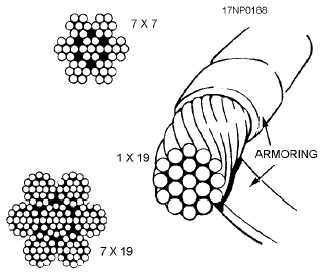weapon training system. It is used to tow aerial targets
for gunnery and aircraft missile firing exercises. The
system
is
a
semiautomatic
tow-reel
and
target-launching mechanism externally mounted on the
aircraft.
The
A/A47U-3A
system
consists
of
an
RMK-19A/A47U-3 reeling machine launcher, a
PEK-84/A47U-3 reeling machine-launcher control,
and the applicable interconnection cable assemblies.
The system uses saddle-mounted aerial targets from 7
to 12.5 inches in diameter that weigh up to 225 pounds.
Target towlines, which have constant diameters or
stepped diameters with combinations of monofilament
and/or stranded wire, are used. The system operates
with various towline splices, ranging in diameter up to
0.250 inch and with flexible lengths up to 106 inches.
Typical towlines consist of 10,000 feet of 0.190-inch
diameter 3 by 7 stranded steel cable (5,400-pound
tensile strength) or 42,000 feet of 0.097-inch diameter
1 by 7 stranded steel cable (2,060-pound tensile
strength). The reeling machine-launcher system has a
nominal reeling speed capability of 3,500 feet of
towline per minute. Adjusting the power unit blade
angle limitations increases the speed to a maximum of
5,000 feet per minute.
The operator manually controls the system, and it
provides launcher up/down, brake on/off, and reel
in/out functions. You can control target reeling and
recovery speeds by manually adjusting the power unit
blade angle. Operation of the system is controlled from
the PEK, which is located in the cockpit of the
launching aircraft.
The
A/A47U-4
tow
target
reeling
machine-launcher
system
is
identical
to
the
A/A74U-3A except for weight and size. The lighter
weight and smaller size design of the A/A47U-4 was
developed to adapt this towing system to a variety of
aircraft.
If you want more information on the A/A47U-3A
tow target reeling machine-launcher system, refer to
Tow
Target
Reeling
Machine-launcher
System
A/A47U-3A, NAVAIR 28-10A-16.
TOW CABLES AND ASSOCIATED
EQUIPMENT
Steel cables used in target towing are manufactured
specifically for that purpose. Three of the several types
of cables used are discussed here: the 3/32-inch, 7 by 7
cable; the 1/8-inch, 7 by 19 cable; and the 1/8-inch,
1 by 19 armored cable.
The 3/32-inch cable comes in 10,000-foot spools,
has a minimum breaking strength of 920 pounds when
new, and is 7 by 7 in construction. It consists of seven
strands; each strand has seven wires, and is commonly
referred to as 7 by 7. This cable weighs 1.5 pounds per
100 feet.
The 1/8-inch cable is shipped in either 11,500- to
12,500-foot spools or 7,000- to 7,500-foot spools. It has
a minimum breaking strength of 2,000 pounds when
new. It is 7 by 19 in construction (7 strands, 19 wires per
strand) and weighs 2.9 pounds per 100 feet.
The 1/8-inch-armored cable is shipped in spools. It
has a minimum breaking strength of 2,160 pounds. It is
constructed of one strand of 19 wires, with a flat
armoring wire swaged spirally around the strand with a
minimum of 6 turns per inch. The armored cable
weighs 4 pounds per 100 feet. Cross-sectional views of
these three cables are shown in figure 8-4.
These cables are not lubricated. The use of grease,
oil, paraffin, or other lubricants on the cable is a fire
hazard. An explosive vapor is created in the towing
aircraft as the cable is reeled out at high speeds. Since
the cables are not lubricated, they must be stored in a
dry
place,
or
cleaned
and
coated
with
corrosion-preventive
compound
according
to
instructions.
Continual use of a cable reduces its strength. Target
towing subjects the cable to severe stress in addition to
the damage caused by gunfire. You need to inspect
cables frequently. The cable should be repaired or
replaced if there are indications of fraying (broken
wires), birdcaging (partial unwinding of the strands
along the cable), or snarling (unwinding of the strands
8-4
Figure 8-4.—Cross-sectional view of tow cables.


